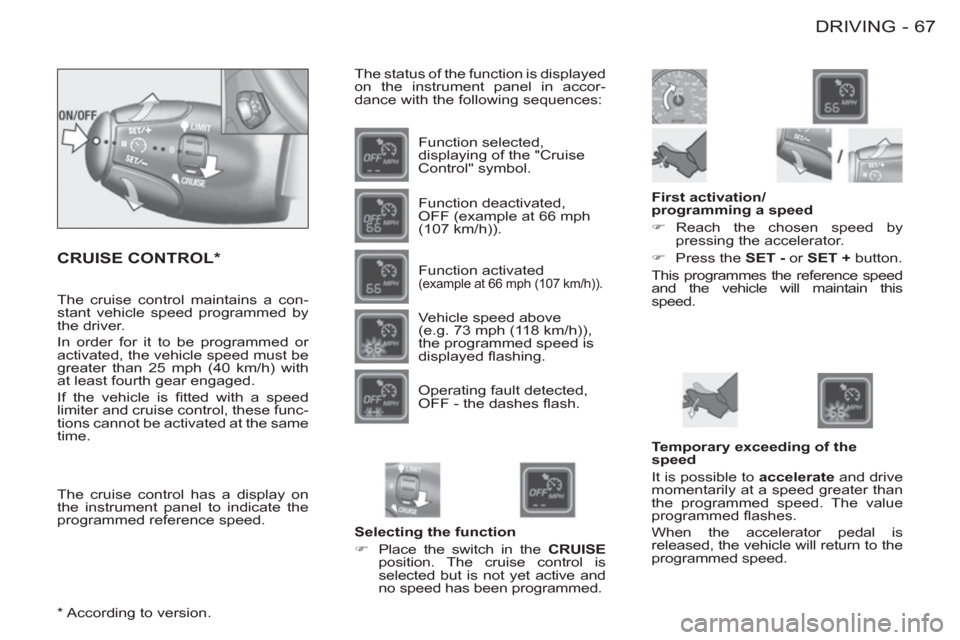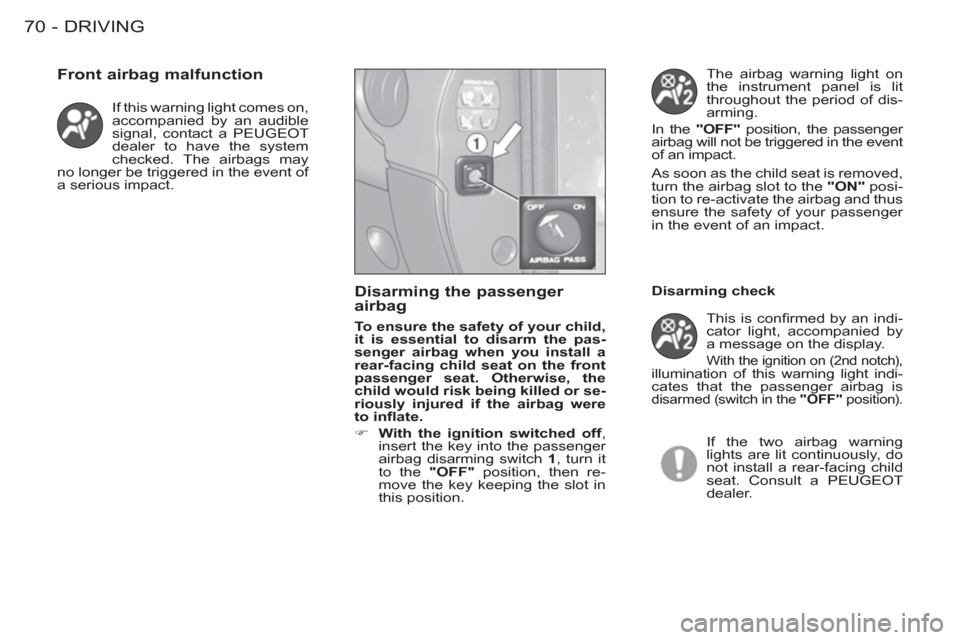Page 69 of 128

67 DRIVING
-
CRUISE CONTROL *
The status of the function is displayed
on the instrument panel in accor-
dance with the following sequences:
Function selected,
displaying of the "Cruise
Control" symbol.
Function deactivated,
OFF (example at 66 mph
(107 km/h)).
Function activated
(example at 66 mph (107 km/h)).
Vehicle speed above
(e.g. 73 mph (118 km/h)),
the programmed speed is
displayed fl ashing.
Operating fault detected,
OFF - the dashes fl ash.
Selecting the function
�)
Place the switch in the CRUISE
position. The cruise control is
selected but is not yet active and
no speed has been programmed.
First activation/
programming a speed
�)
Reach the chosen speed by
pressing the accelerator.
�)
Press the SET -
or SET +
button.
This programmes the reference speed
and the vehicle will maintain this
speed.
Temporary exceeding of the
speed
It is possible to accelerate
and drive
momentarily at a speed greater than
the programmed speed. The value
programmed fl ashes.
When the accelerator pedal is
released, the vehicle will return to the
programmed speed. The cruise control has a display on
the instrument panel to indicate the
programmed reference speed. The cruise control maintains a con-
stant vehicle speed programmed by
the driver.
In order for it to be programmed or
activated, the vehicle speed must be
greater than 25 mph (40 km/h) with
at least fourth gear engaged.
If the vehicle is fi tted with a speed
limiter and cruise control, these func-
tions cannot be activated at the same
time.
*
According to version.
Page 72 of 128

DRIVING70 -
If this warning light comes on,
accompanied by an audible
signal, contact a PEUGEOT
dealer to have the system
checked. The airbags may
no longer be triggered in the event of
a serious impact.
Front airbag malfunction
Disarming the passenger
airbag
To ensure the safety of your child,
it is essential to disarm the pas-
senger airbag when you install a
rear-facing child seat on the front
passenger seat. Otherwise, the
child would risk being killed or se-
riously injured if the airbag were
to infl ate.
�)
With the ignition switched off
,
insert the key into the passenger
airbag disarming switch 1
, turn it
to the "OFF"
position, then re-
move the key keeping the slot in
this position. The airbag warning light on
the instrument panel is lit
throughout the period of dis-
arming.
In the "OFF"
position, the passenger
airbag will not be triggered in the event
of an impact.
As soon as the child seat is removed,
turn the airbag slot to the "ON"
posi-
tion to re-activate the airbag and thus
ensure the safety of your passenger
in the event of an impact.
This is confi rmed by an indi-
cator light, accompanied by
a message on the display.
With the ignition on (2nd notch),
illumination of this warning light indi-
cates that the passenger airbag is
disarmed (switch in the "OFF"
position).
If the two airbag warning
lights are lit continuously, do
not install a rear-facing child
seat. Consult a PEUGEOT
dealer.
Disarming check
Page 79 of 128

77 PRACTICAL INFORMATION
-
CHECKING LEVELS
Dipstick
Oil change
According to the information given in
the servicing booklet.
Viscosity selection
In all cases, the oil selected must meet
the manufacturer's requirements.
Note:
the coolant does not need to
be changed.
For vehicles equipped with a par-
ticle fi lter, the engine fan may ope-
rate after the ignition has been
switched off, even when the engine
is cold.
There are two marks
on the dipstick:
A
= maximum
Never fi ll past this mark.
B
= minimum
To maintain the reliability
of engines and emission
control systems, the use
of additives in engine oil
is prohibited.
Brake fluid level
The brake fl uid must be changed ac-
cording to the manufacturer's servicing
schedule.
Use fl uids recommended by the manu-
facturer, which fulfi l DOT4 standards.
Cooling system
Use the fl uid recommended by the
manufacturer.
When the engine is warm, the tem-
perature of the coolant is controlled
by the engine fan. As this fan can op-
erate with the ignition key removed
and because the cooling system is
pressurised, wait for at least one hour
after the engine has stopped before
carrying out any work.
Slacken the cap by two turns to re-
lease the pressure to prevent any
risk of scalding. When the pressure
has dropped, remove the cap and
top up the level.
Power steering reservoir
�)
Open the reservoir, with the en-
gine at ambient temperature. The
level should always be above the
MIN. mark and close to the MAX.
mark.
Windscreen and headlamp
wash level
For best quality cleaning and for
your safety, we would advise that
you use products recommended by
PEUGEOT.
For optimum cleaning and to prevent
freezing, this fl uid must not be topped
up or replaced with water.
Used products
Avoid products such as used oil and
brake fl uid coming into prolonged
contact with the skin.
Do not dispose of used oil, brake
fl uid or coolant into drains or onto
the ground. Empty used oil into the
containers provided for this purpose
in the PEUGEOT dealer network
(France) or to an authorised waste
disposal site.
Oil level
It is normal to top up the engine oil
between services. PEUGEOT recom-
mends that you check the oil level, and
top up if necessary, every 3 000 miles
(5 000 kilometres).
Check the level with the vehicle level,
engine cold, using the oil level gauge
on the instrument panel or the dipstick.
Page 91 of 128
89 PRACTICAL INFORMATION
-
Fuse N°
Rating
Functions
1
15A
Rear wiper.
4
20A
Multifunction screen - Instrument panel - Audio
system - Steering mounted controls.
5
-
Not used.
6
10A
Diagnostic socket.
7
-
Not used.
9
30A
Heated seats.
10
40A
Rear window and door mirrors demisting.
11
15A
Rear wiper (tailgate).
12
30A
Front electric windows.
14
10A
Engine fusebox - Steering mounted controls.
15
15A
Instrument panel - Multifunction screen - Audio
system.
16
30A
Locking/unlocking controls for doors, bonnet and boot.
20
10A
Right-hand brake lamp.
21
15A
Left-hand brake lamp.
22
20A
Front courtesy lamp - Map reading lamp - Cigarette
lighter - Electric mirror.
Page 122 of 128
VISUAL INDEX120 -
INSTRUMENTS AND CONTROLS
Instrument panel, dials,
speedometer ............................ 20
Warning lamps,
indicator lamps ....................21-23
Indicators, displays, screen ...23-27
Setting the time,
dimmer, resetting to zero .....25-27
Interior fuses ..........................88-90
Opening the bonnet .............. 16, 53
Parking brake,
handbrake .......................... 64, 78 Overhead storage, sun visor,
courtesy lamp ................14, 58-59
Rear view mirror ......................... 57
Front fi ttings ...........................58-59 Electric windows ......................... 56
Hazard warning
lamps ........................................ 60
Audio system ..................... 110-117
Fitting an audio system,
speakers ................................... 93
Heating/
Air conditioning ........ 28-31, 32-33
- vent, demisting, defrosting
- air conditioning A/C,
- air recirculation,
- ventilation.